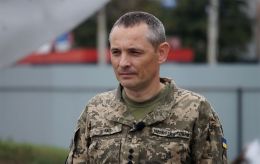Pentagon explains why US deploys troops to Middle East
 Pentagon Press Secretary Air Force Maj. Gen. Pat Ryder (photo: facebook.com/PatrickSRyder)
Pentagon Press Secretary Air Force Maj. Gen. Pat Ryder (photo: facebook.com/PatrickSRyder)
In the Middle East, there is still time for diplomacy and a possibility to prevent a large-scale regional war, states Pentagon spokesperson Pat Ryder during a briefing.
According to Ryder, US troops are being redeployed to the area of responsibility of US Central Command for a deterrence mission.
Specifically, the US Air Force has moved F-22 Raptor jets to the region, while the US Navy is deploying the aircraft carrier strike group Abraham Lincoln, which includes F-35C Lightning II jets. Additionally, the region is receiving the guided-missile submarine USS Georgia.
Ryder noted that there are currently about 40,000 American service members in the Middle East.
The Department of Defense continues to closely monitor the situation. Secretary of Defense Lloyd Austin communicates almost daily with Israeli Defense Minister Yoav Gallant and other regional partners.
“The US remains intensely focused on de-escalating tensions in the region, while also remaining focused on securing a cease-fire as part of a hostage deal to bring all of the hostages home and to end the war in Gaza,” Ryder said.
Protecting Israel ensures deterrence
During the latest phone call with Gallant, Austin assured the US commitment to taking all necessary measures to protect Israel.
The Pentagon chief also highlighted the strengthening of US military positions and capabilities in the Middle East in response to the escalation of regional tensions.
“These US military force-posture adjustments are designed to improve US force protection, to increase our support for the defense of Israel, and to ensure the US is prepared to respond to a wide variety of contingencies,” Ryder said.
According to Ryder, Austin and Gallant also discussed Israeli operations in the Gaza Strip, with the Secretary of Defense reiterating the importance of minimizing civilian casualties.
Iran and its allied groups have threatened to attack Israel, and Ryder emphasized that the US must take these threats seriously.
“But our focus is on de-escalating tensions, working on enabling that cease-fire, and getting the hostages returned,” the spokesperson said.
Ryder stated that the US aims to prevent a broader regional war in the Middle East.
“No one wants to see escalation. No one wants to see a wider, regional conflict. So, hopefully, we don't find ourselves in a situation of having to employ those capabilities. But if we need to in the defense of Israel, we will,” Ryder said.
Threat of a large-scale war in the Middle East
At the end of July, Israeli intelligence forces eliminated Ismail Haniyeh, a political leader, in Tehran. In addition, an Israeli airstrike killed Hezbollah commander Fuad Shukr in Lebanon.
In response, Iran and Islamic groups, including Hamas, Yemen's Houthis, and Lebanon's Hezbollah, vowed to launch a massive retaliatory strike against Israel for the killing of their commanders.
The US has confirmed Israel's intelligence reports that Tehran is preparing for an attack.
The US will sell Israel F-15 fighter jets and other military equipment worth $20 billion.

